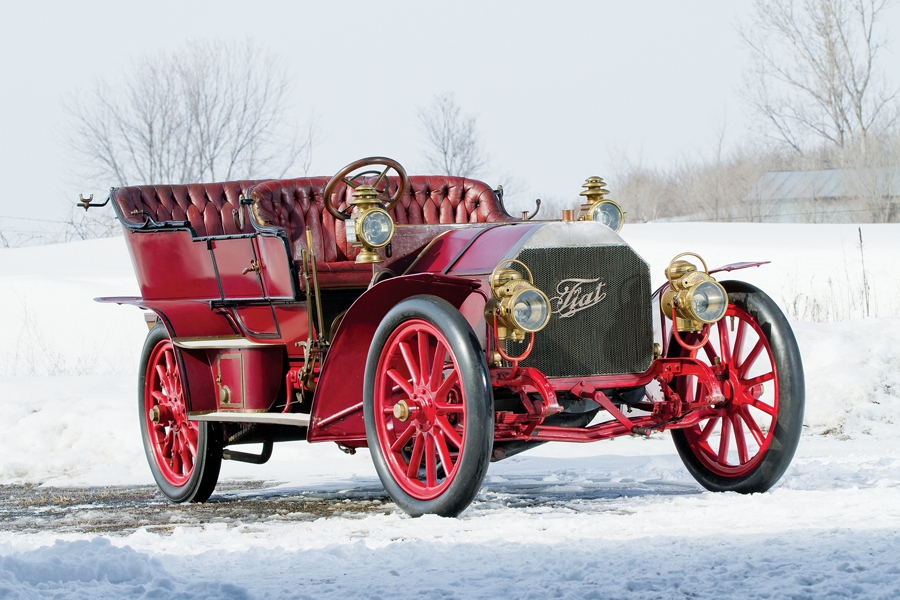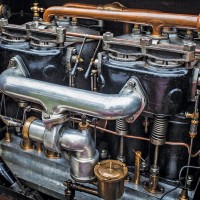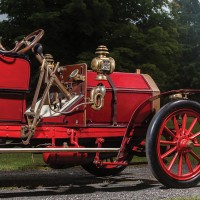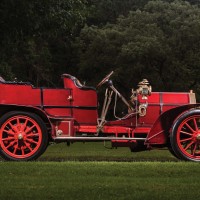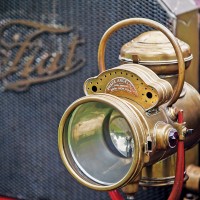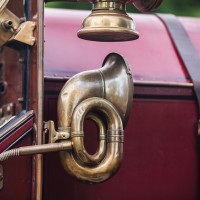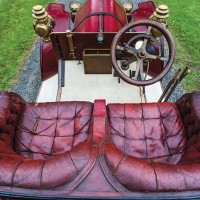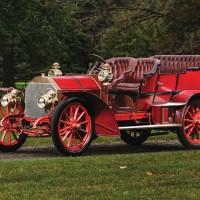SCM Analysis
Detailing
| Vehicle: | 1905 Fiat 60 HP 5-Passenger Tourer |
| Number Produced: | 20 |
| Original List Price: | $14,000 |
| Tune Up Cost: | $475 |
| Distributor Caps: | Dashboard tag |
| Chassis Number Location: | Right engine mount arm |
| Alternatives: | 1905 Mercedes 60 hp, 1905 Simplex, 1906 Daimler TP 45, 1907 Rolls-Royce 40/50 Silver Ghost |
| Investment Grade: | B |
This car, Lot 257, sold for $825,000, including buyer’s premium, at RM Auctions’ Hershey, PA, sale on October 9, 2014.When I was asked to write about the sale of this 109-year-old Fiat, a thought that went through my head concerned all the attention paid recently to discussions of a generational shift in auto collecting.
The debates begin with the basic rule of thumb which adheres to the traditional bell curve of desirability — in which the most coveted collector cars in a specific time are those which are 25 to 35 years old. These are the hot rides which you lusted for as a flat-broke 18-year-old and which you now want to buy as a successful 43–53-year-old. That pattern roughly played itself out from the Model A through big American Classic cars of the 1930s, to the post-war 1950s cars, through 1960s and 1970s muscle cars.
While there are some who think the last really interesting car was made in 1968, many exciting and desirable vehicles have been built since, and it’s not only 30-year-olds who find the BMW E30 M3 and McLaren F1 worth collecting.
However, a closer look reveals that the neat bell curve begins to fuzz at the edges pretty comprehensively when you also account for the maturation of vehicle collecting in general. The “hobby” as we know it only dates from the early 1950s. So, compared with the collections of objects of fine art which erudite citizens of the Roman Empire began to assemble many centuries ago, it’s a bit premature to decide what will and will not survive the taste test of time.
Looking at Brass Era cars such as this Fiat is a good example of the proof that breaks the rule. Chances are that there were relatively few 127-year-olds in the room when this car sold at Hershey, so let’s eliminate the fellows and gals who were 18 when this Fiat was delivered. Yet it brought a very strong price, despite not being old enough to enter in the London-Brighton Run, which has a 1904 cutoff.
The difference between the market desirablility of a car which has, or can obtain, a VCC dating certification allowing it to enter this wonderful event and one which is too new can be up to 100% in some cases. Not everyone wants to actually drive a very old car in very cold and often damp weather — all rather slowly of course — so there are other factors which come into play as well, and power and comfort are high on the list.
The power of power
Since those Edwardian-era teenagers aren’t around to offer their opinion, we have to look at today’s buyers to see what the market likes in cars of this period. And, as is the case with vehicles from every decade from 1930 to 2010, more often than not it’s power.
The cars that command attention — and big money — in this area of the market are the “big iron.” If it’s got 4 cylinders, it better have at least 5,000 cc, and better still are 6 cylinders and over 6,000 cc.
The earliest automotive engineers were explorers, casting out in all directions in the pursuit of speed and reliability.
Even before W. O. Bentley was said to have uttered “There’s no replacement for displacement,” bigger meant faster and better in automotive engines. Considering that the Benz Patent-Motorwagen made do with 952-cc, single-cylinder engine in 1899. Only five years later, Fiat had a a mid-market model, the 24-32 with a 6,371-cc, 4-cylinder engine, which illustrates the progression of cylinder bore and stroke inflation in the first years of the modern motorcar.
A well-preserved survivor
Our Fiat has size covered, with a 10-liter 4-banger under the hood, and add to that a big, comfortable touring body which has the added benefit of being the original one, in superbly preserved condition. That it’s stated to be the only survivor of the production also gives it survivor’s rights. While a few of the smaller 24-32 chassis cars remain, this is said to be the only 60 HP extant. The survivorship is good, but not central, as a value attribute. Rather it is the confluence of specification, the August Busch provenance and condition that gives this vehicle such appeal.
It’s also interesting to note that I first saw this very impressive motor in Italy before RM Auctions offered it at their Villa Erba (Villa d’Este) sale in May 2013.
I was very taken with its aura and obvious originality. I certainly had never been in the presence of a car exactly like it. However, I had been fortunate enough to have seen similar earlier and later cars in Italian museums and private collections. In addition, I recently had the thrill of spending up close and personal time with an early big Fiat for a recent appraisal assignment. These are very fine cars indeed — and a testament to the talent of their engineers and the quality of their factory workers.
This car failed to find a buyer at the Italian auction at a called high bid of $1,690,000 (€1,300,000). I thought at the time it was certainly worth the call, but with the benefit of hindsight, distance and an actual sale, I’ve changed my view.
This car’s best market was indeed in the United States, rather than Italy. It was delivered here, bodied here, owned by names important to North Americans and lived a substantial portion of its life in a small corner of the Northeast.
The price realized at RM’s Hershey sale, while half the called high bid on Lake Como, was still very much in line with the values of other large-engined luxury cars of the era, such as the Mercedes 45 and 60 hp. More of a premium could certainly be paid for the originality and concours history, and it is a remarkable car. However, the reality is that a Fiat, even one as grand as this, loses a bit of “bar-stool boastability.” It’s not fair, nor does it make sense, but there you are. I would certainly call this one well bought, but not badly sold either. ♦
(Introductory description courtesy of RM Auctions.)
